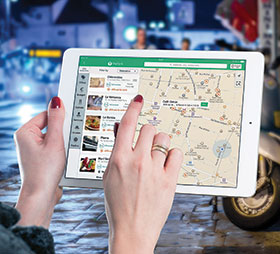

Mobility – the rise of Internet-enabled smartphones and tablets – is radically changing the way that business systems operate: enhancing the value of video and providing visual awareness at the edge of the network where it can have the most powerful and immediate impact.

The Internet, we can probably all agree, is pretty great. Not only can we share our photos with far-flung family and friends, we can also do some pretty nifty things with it in our working lives too. It continues to provide a seemingly endless set of possibilities for companies to help them work harder, better and smarter. And now mobility adds another range of opportunities into the mix.
The mobile Internet enables huge swathes of the world’s population to more rapidly access information and engage with others on a scale never seen before. For businesses, this goes beyond traditional systems like Enterprise Resource Planning (ERP) software: video-enhanced business systems used for securing people and assets are the next in line to be given the mobile device treatment.
And this trend doesn’t stop there.
Next up is the concept of the Internet of Safety Things. The IoST is concerned with connected smart assets and sensors which are able to collect and share data, enabling new insights that can transform a standard company into a data driven business. It’s a specialised Internet of Things, with safety and security-centric devices communicating to deliver enhanced functionality and powerful, actionable information.
Beyond the IoST lies Managed Visual Services: the capability of effectively and meaningfully using video from hundreds or thousands of connected sensors.
Can you handle it?
With mobile devices becoming so commonplace, and with the trends mentioned above rapidly developing, the systems that handle them also need to evolve. They can’t be the same systems designed for a non-mobile, stationary world, where cameras are only ever mounted on walls and all networks are wired. They need to be built with the understanding that the notion of a ‘system’ is flexible and expandable, according to the way technology and applications develop.
We’re talking, of course, about concepts like open platform technology – platforms that can provide organisations with the necessary adaptability to ensure that they can implement changes when and where they are needed, according to their business requirements.
So while the IoST might be in its early stages, where standards, privacy issues and administration have yet to cohere into a more mature and corporate-ready, implementable concept, mobility is clearly alive and very present today in the form of smartphones and tablet computers.
Consumer adoption of both categories is, we know, widespread – and now mobility is broadening its reach into the corporate world as well. Tablet computers, a category that barely existed three years ago, is estimated to grow by almost 50% per year in enterprise use, according to a recent IBM study.
Data from the same study indicates that individuals are using both mobile phones and tablet computers to accomplish a wide range of work activities that were previously restricted to desktops. These activities range from accessing email (62% via phone, 38% via tablet) to collaboration and project management (25% via phone, 34% via tablet) to videoconferences (30% by phone, 33% via tablet). The study concludes: “The ability to perform these and access other enterprise applications from non-traditional office settings holds the possibility to reinvent at a fundamental level how companies execute a range of activities – from sales and customer service to logistics and maintenance.”
Video business systems also benefit from this focus on mobility: “Mobile strategy leaders have also seen clear benefits in their mobile investments to date: 73% of leaders have seen measurable ROI from their mobile initiatives versus 34% of all other companies in our study. Further, 81 percent stated that mobile capabilities are fundamentally changing the way their organisations do business,” the study says.
Mobile video: a radical departure
When smartphones or tablets are used as clients, they enable a radical shift in how the VMS (video management system) is used. They allow a decentralised workflow where video feeds can be used everywhere, not just in front of a smart wall.
Push alerts to mobile devices effectively break the monitor-wall restriction, removing the last barriers for true mobile video systems. It’s no longer a single operator handling an alarm and using video feeds to investigate the incident further, manually setting in motion the proper actions for resolving the incident. Push alerts now mean the person responsible for resolving the incident gets all the information they need to do so, directly.
Using the mobile video client, the responder can access the VMS and get the full story without delay or the filter of interpretation. This not only improves the quality of the response, it’s also much more convenient for the responder.
One example of this is the system at Copenhagen zoo. The zoo has numerous gates for receiving supplies. All of these gates are unmanned, meaning that, previously, an employee had to leave the zoo administration building when access was requested and walk to the gate to verify the identity of the visitor and allow them entry. But now, by using a mobile client integrated with the zoo’s VMS, any authorised employee can access the video feed from the camera covering the gate in question, verify the identity of the delivery and open the gate remotely. The use of mobile clients saves the zoo 180 man-days a year, improves handling of deliveries due to reduced waiting times, and heightens security.
Mobile clients can also benefit more traditional video security installations. The Skult chain of hairdressers in Sweden use their video installation for security and improving salon efficiency. But in their new video infrastructure no traditional clients are used. They operate with mobile clients only.
This enables the owner of Skult to ensure that every salon in the chain meets her standards, and can quickly handle security incidents, no matter where she is. But it’s not just security incidents that can be monitored, as CEO and owner Maria Jörgensen explains: “If I want to, I can check up on my salons when I sit at home. Then I can call the store right away if decorations at the store need to be changed, for example. It is great to have such flexibility.”
Cameras on the move
This is impressive stuff. But mobile devices can be used for much more than just functioning as a mobile video client. Consider this: all smartphones and tablets have an integrated video camera, they have fairly accurate time services, and nearly all are GPS-enabled. The more advanced devices add a compass to the feature set. These features make mobile devices very capable cameras for use in a VMS-context. Add to this the availability of nearly omnipresent fast data connections, and the resulting practical devices enable a large number of new uses.
The ability to push video to a central VMS from mobile devices, complete with evidence class metadata like GPS position, camera direction and time of day, is a truly compelling concept. It offers the potential to report incidents at locations not covered by stationary cameras; it can provide extra, complementary angles to recordings from stationary cameras; and it could be used to provide additional video data, as smartphones have plenty of capacity for running video analytics. Of course, optimised video push capabilities demand that the VMS is adaptable and capable of handling the video metadata. If it can’t, the use of mobile devices as effective cameras is, at best, difficult.
Building for the future
It’s clear that the corporate use of mobile devices is increasing. This means that business systems, infrastructure and workflow will now all have to be designed, or adapted, to accommodate these devices.
Video business systems are no exception here. The use of mobile devices as clients can improve productivity, as they enable a ‘watch and react everywhere’ workflow. Video pushed from mobile devices is enabling both new opportunities and giving first responders to incidents ways to be more efficient.
All of this demands a VMS with a high degree of adaptability and true openness – a video management system built with an understanding of the requirements of the new era of mobility.
For more information contact Milestone Systems, +27 (0)82 377 0415, [email protected], www.milestonesys.com
| Tel: | +27 10 500 8793 |
| Email: | [email protected] |
| www: | www.milestonesys.com |
| Articles: | More information and articles about Milestone Systems |
© Technews Publishing (Pty) Ltd. | All Rights Reserved.